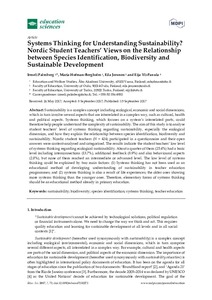Systems Thinking for Understanding Sustainability? Nordic Student Teachers’ Views on the Relationship between Species Identification, Biodiversity and Sustainable Development
Eila Jeronen; Eija Yli-Panula; Irmeli Palmberg; Maria Hofman-Bergholm
https://urn.fi/URN:NBN:fi-fe2021042717050
Tiivistelmä
Sustainability is a complex concept including
ecological, economic and social dimensions, which in turn involve several
aspects that are interrelated in a complex way, such as cultural, health and
political aspects. Systems thinking, which focuses on a system’s interrelated
parts, could therefore help people understand the complexity of sustainability.
The aim of this study is to analyse student teachers’ level of systems thinking
regarding sustainability, especially the ecological dimension, and how they
explain the relationship between species identification, biodiversity and
sustainability. Nordic student teachers (N
= 424) participated in a questionnaire and their open answers were
content-analysed and categorised. The results indicate the student teachers’
low level of systems thinking regarding ecological sustainability. About a
quarter of them (25.4%) had a basic level including interconnections (13.7
Academic Editor: name), additional feedback (8.9%) and also behavioural aspects
(2.8%), but none of them reached an intermediate or advanced level. The low
level of systems thinking could be explained by two main factors: (1) Systems
thinking has not been used as an educational method of developing understanding
of sustainability in teacher education programmes; and (2) systems thinking is
also a result of life experiences; the older ones showing more systems thinking
than the younger ones. Therefore, elementary forms of systems thinking should
be an educational method already in primary education.
Kokoelmat
- Rinnakkaistallenteet [19207]
